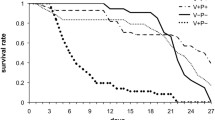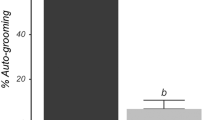Abstract
The impact of genetically modified oilseed rape (Brassica napus L.) on the foraging behaviour of honey bees (Apis mellifera L.) was evaluated on two different lines transformed to express constitutively heterologous chitinase in somatic tissue for enhanced disease resistance. Experiments were conducted in confinement in an indoor flight room with controlled conditions and in an outdoor flight cage with conditions more representative of the open environment. Foraging behaviour was analysed by observations of general bee behaviour (total number of visits) and of individual bee behaviour (using a video camera coupled with a special software program to process the data). The plants were analysed in terms of nectar quantity and quality (nectar volume and sugar content). The results showed no effects on bee foraging behaviour due to the modification of the genome of these plants by the introduction of a chitinase gene even though some differences between lines were found in the nectar. The methods applied in this original approach for the evaluation of the impact of genetically modified oilseed rape were shown to be sufficiently sensitive to detect changes in bee behaviour resulting from differences between plants.
Similar content being viewed by others
References
Baker, H.G. and Baker, I. (1983) A brief historical review of the chemistry of floral nectar. In Bentley, B. and Elias, T. ed. The Biology of Nectaries. pp. 126–53. Colombia University Press.
Black, L.T. and Bagley, E.B. (1978) Determination of oligosaccharides in soybeans by high pressure liquid chromatography using an internal standard.J. Am. Oil Chemists' Soc. 55, 228–32.
Broglie, K.E., Gaynor, J.J. and Broglie, R.M. (1986) Ethylene-regulated gene expression: molecular cloning of the genes encoding an endochitinase fromPhaseolus vulgaris.Proc. Natl Acad. Sci. USA 83, 6820–4.
Dale, P.J., Irwin, J.A. and Scheffler, J.A. (1993) The experimental and commercial release of transgenic crop plants.Plant Breeding 111, 1–22.
Guerche, P., Jouanin, L., Tepfer, D. and Pelletier, G. (1987) Genetic transformation of oilseed rape (Brassica napus L.) by the Ri T-DNA ofAgrobacterium rhizogenes and analysis of inheritance of the transformed phenotype.Mol. Gen. Genet. 206, 382–6.
Heinrich, B. (1975) Energetics of pollination.Annu. Rev. Ecol. Syst. 6, 139–70.
Kramer, K. and Koja, D. (1986) Insect chitin: Physical state, synthesis, degradation and metabolic regulation.Insect Biochem. 16, 851–77.
Krell, R. and Dietz, A. (1986) Foraging behaviour ofApis mellifera ligustica on Gallberry (Ilex glabra). Proceedings of the XXXth International Congress of Apiculture, Nagoya, 109–113.
Mesquida, J. and Renard, M. (1981) Pollinisation du colza d'hiver mâle-stérile et mâle-fertile (Brassica napus L. var.oleifera Metzger) par I'abeille domestique (Apis mellifera L.). Effets sur la phénologie et le rendement.Apidologie 12, 345–62.
Mesquida, J., Pham-Delègue, M.H., Marilleau, R., Metayer, M. le and Renard, M. (1991) La sécrétion nectarifère des fleurs de cybrides mâle-stérile de colza d'hiver (Brassica napus L.).Agronomie 11, 217–27.
Molano, J., Duran, A. and Cabib, E. (1977) A rapid and sensitive assay for chitinase using tritiated chitin.Anal. Biochem. 83, 648–56.
Odell, J.T., Nagy, F. and Chua, N.H. (1985) Identification of DNA sequences required for activity of the cauliflower mosaic virus 35S promoter.Nature 313, 810–2.
Renard, M. and Mesquida, J. (1978) Importance relative des sécrétions nectarifères sur le comportement de butinage des abeilles et la pollinisation du colza mâle-stérile en production de semences.Bull. Tech. Apic. 147, 93–7.
Schmid-Hempel, P. (1987) Efficient nectar-collecting by honeybees. I Economic model.J. Anim. Ecol. 56, 209–18.
Schmid-Hempel, P. and Schmid-Hempel, R. (1987) Efficient nectar-collecting by honeybees. II Response to factors determining nectar availability.J. Anim. Ecol. 56, 219–27.
Skujins, J.J., Potgierger, H.J. and Alexander, M. (1965) Dissolution of fungal cell walls by a streptomycete chitinase and β-1,3 glucanase.Arch. Biochem. Biophys. 111, 358–64.
Towbin, H., Staehelin, T. and Gordon, J. (1979) Electrophoretic transfer of proteins from polyacrylamide gels to nitrocellulose sheets procedure and some applications.Proc. Natl Acad. Sci. USA 76, 4350–4.
Waddington, K.D. (1980) Flight patterns of foraging honey bees relative to density of artificial flowers and distribution of nectar.Oecologia 44, 199–204.
Woodrow, A.W. (1968) Some factors affecting selection of sucrose by foraging honeybees.Am. Bee J. 108, 313–5.
Wykes, G.R. (1953) The sugar content of nectars.Biochem. J. 53, 294–6.
Zimmerman, M. (1983) Plant reproduction and optimal foraging: experimental manipulations inDelphinium nelsonii.Oikos 41, 57–63.
Author information
Authors and Affiliations
Rights and permissions
About this article
Cite this article
Picard-Nizou, A.L., Pham-Delègue, M.H., Kerguelen, V. et al. Foraging behaviour of honey bees (Apis mellifera L.) on transgenic oilseed rape (Brassica napus L.var. oleifera). Transgenic Research 4, 270–276 (1995). https://doi.org/10.1007/BF01969121
Received:
Revised:
Accepted:
Issue Date:
DOI: https://doi.org/10.1007/BF01969121




